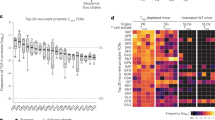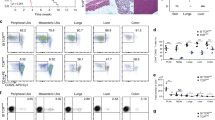Abstract
IN the thymus there are two major mechanisms of T-lymphocyte tolerance: clonal deletion and clonal inactivation1–3. One important problem underlying the mechanism of clonal inactivation is why unresponsive cells are maintained in the mature peripheral T-cell repertoire. Here we report that transgenic αβ T-cells may be tolerized to a self antigen Mls-la, but still retain proliferative responses for alternative peptide antigens and superantigens. These self-tolerant T cells can also provide immunopathological and memory cytotoxic function in vivo. We propose that high-affinity/avidity self-reactive T cells are deleted in the thymus, whereas lower-affinity/avidity interactions lead to unresponsiveness and define the ‘resting threshold’ for a given T cell. These low-affinity self-tolerant T cells remain functionally competent for high-affinity foreign antigens, and efficiently eliminate natural pathogensin vivo.
This is a preview of subscription content, access via your institution
Access options
Subscribe to this journal
Receive 51 print issues and online access
$199.00 per year
only $3.90 per issue
Buy this article
- Purchase on Springer Link
- Instant access to full article PDF
Prices may be subject to local taxes which are calculated during checkout
Similar content being viewed by others
Change history
01 November 1995
A Correction to this paper has been published: https://doi.org/10.1038/378419c0
References
Ramsdell, F. & Fowlkes, B. J. Science 248, 1342–1348 (1990).
von Boehmer, H. & Kisielow, P. Science 248, 1369–1372 (1990).
Schwartz, R. H. Science 248, 1349–1356 (1990).
Pircher, H., Bürki, K., Lang, R., Hengartner, H. & Zinkernagel, R. Nature 342, 559–561 (1989).
Kappler, J. W., Staerz, U. D., White, J. & Marrack, P. Nature 332, 35–40 (1988).
White, J. et al. Cell 56, 27–35 (1989).
Ohashi, P. S., Pircher, H., Bürki, K., Zinkernagel, R. M. & Hengartner, H. Nature 346, 861–863 (1990).
Baenziger, J., Hengartner, H., Zinkernagel, R. M. & Cole, G. A. Eur. J. Immun. 16, 387–393 (1986).
Fung-Leung, W. P., Kündig, T. M., Zinkernagel, R. M. & Mak, T. W. J. exp. Med. 174, 1425–1429 (1991).
Blackman, M. A. et al. Nature 345, 540–542 (1990).
Yui, K., Komori, S., Katsumata, M., Siegel, R. M. & Greene, M. I. Proc. natn. Acad. Sci. U.S.A. 87, 7135–7139 (1990).
Ramsdell, F. & Fowlkes, B. J. Science 257, 1130–1134 (1992).
Sloan-Lancaster, J., Evavold, B. & Allen, P. M. Nature 363, 156–159 (1993).
Röcken, M., Urban, J. F. & Shevach, S. M. Nature 359, 79–82 (1992).
Rocha, B., Tanchot, C. & von Boehmer, H. J. exp. Med. 177, 1517–1521 (1993).
von Boehmer, H., Kirberg, J. & Rocha, B. J. exp. Med. 174, 1001–1008 (1991).
Yan, S. J., Li, S. Y., Imanishi, K., Kumazawa, Y. & Uchiyama, T. J. Immun. 150, 3873–3881 (1993).
Tomonari, K. Immunogenetics 28, 455–458 (1988).
Pircher, H. et al. Eur. J. Immun. 22, 399–409 (1992).
Haskins, K. et al. J. exp. Med. 160, 452–471 (1984).
Pircher, H. et al. Eur. J. Immun. 17, 159–166 (1987).
Pircher, H., Hoffmann Rohrer, U., Moskophidis, D., Zinkernagel, R. M. & Hengartner, H. Nature 351, 482–485 (1991).
Author information
Authors and Affiliations
Rights and permissions
About this article
Cite this article
Kawai, K., Ohashi, P. Immunological function of a defined T-cell population tolerized to low-affinity self antigens. Nature 374, 68–69 (1995). https://doi.org/10.1038/374068a0
Received:
Accepted:
Issue Date:
DOI: https://doi.org/10.1038/374068a0
This article is cited by
-
Immunogenic HER-2/neu peptides as tumor vaccines
Cancer Immunology, Immunotherapy (2006)
-
Self-reactivity in thymic double-positive cells commits cells to a CD8αα lineage with characteristics of innate immune cells
Nature Immunology (2004)
-
Maintenance and loss of self-tolerance in B cells
Springer Seminars in Immunopathology (2001)
-
T-cell homeostasis in HIV infection is neither failing nor blind: Modified cell counts reflect an adaptive response of the host
Nature Medicine (1997)
Comments
By submitting a comment you agree to abide by our Terms and Community Guidelines. If you find something abusive or that does not comply with our terms or guidelines please flag it as inappropriate.



